#Red list of threatened species
Text
IUCN Director General Message for World Wildlife Day 2024.
youtube
Message for World Wildlife Day 2024 by the International Union for Conservation of Nature (IUCN), Director General Mr. Grethel Aguilar.
#IUCN#world wildlife day#wildlife#3 march#Red list of threatened species#statements#International Union for Conservation of Nature (IUCN)#IUCN Species Survival Commission#IUCN Pangolin Specialist Group#Youtube
0 notes
Link
#adventure travel#africa#antipoaching#big cats#biodiversity#candice gaukel andrews#conservation#endangered species#iucn#lead poisoning#leopards#lions#nature#nature lovers#natural habitat adventures#nathab#poaching#red list of threatened species#science#scientific research#trophy hunting#victoria falls#wild#wildlife#wildlife poaching#world wildlife fund#wwf#zambia
0 notes
Text

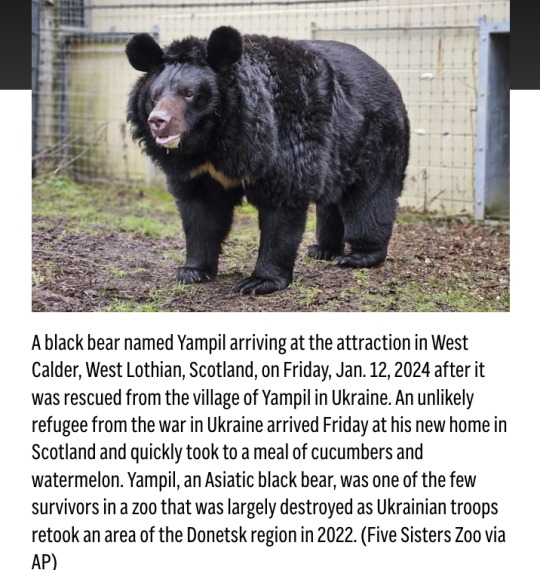
By Brian Melley, AP News
13 January 2024
LONDON (AP) — An unlikely refugee from the war in Ukraine — a rare Asiatic black bear — arrived at his new home in Scotland on Friday and quickly took to a meal of cucumbers and watermelon.
The 12-year-old Yampil was named for a village in the Donetsk region where he was one of the few survivors found by Ukrainian troops in the remains of a bombed-out private zoo.
Yampil, who had previously been called Borya, was discovered by soldiers who recaptured the devastated city of Lyman during the Kharkiv counteroffensive in the fall of 2022, said Yegor Yakovlev of Save Wild, who was among the first of many people who led the bear to a new life.
The bear was found in a menagerie that had long been abandoned by its owners.
Almost all the other animals had died of hunger, thirst or were struck by bullets or shrapnel and some were eaten by Russian troops.
Yampil narrowly missed the same fate, suffering a concussion from a projectile that landed nearby.
“The bear miraculously survived,” said Yakovlev, also director of the White Rock Bear Shelter, where the bear recovered.
“Our fighters did not know what to do with him, so they started looking for rescue.”
What followed was an odyssey that your average bear rarely makes, as he was moved to Kyiv for veterinary care and rehab, then shipped to a zoo in Poland, then to an animal rescue in Belgium, where he spent the past seven months, before landing in the United Kingdom.
Brian Curran, owner of Five Sisters Zoo in West Calder, Scotland, said his heart broke when he learned of the plight of the threatened Asiatic black bear.
“He was in terrible condition; five more days and they wouldn’t have been able to save him,” Curran said. “We were just so amazed he was still alive and well.”
The bear was skinny but not malnourished when he was found, said Frederik Thoelen, a biologist at the Nature Help Center in Belgium.
He now is estimated to weigh a healthy 440 pounds (200 kilograms), Thoelen said.
The nature center in Belgium, which usually treats injured wildlife and returns them to their natural settings, has taken several animals rescued from the war in Ukraine, including a wolf, a caracal cat and four lions, though those animals had not experienced the ordeal Yampil endured.
It was remarkable how calm Yampil was when he arrived in Belgium, Thoelen said.
The bear was trained in the past two weeks to move from his enclosure to the crate that would transport him across Belgium to Calais, France, then across the English Channel on a ferry to Scotland.
Pastries from a local bakery were used for good measure to lure him Thursday into the cage, where he was sedated for the journey.
“We want to use the food that he likes most, and for most bears — and for people also — it’s sweet, unhealthy foods,” Thoelen said.
Thoelen had a sense of the bear’s weight as he drove the crate to the port.
“Every time when we had a red light or a traffic jam, when the bear moved a little bit, you could feel the van moving also,” he said.
“You could feel it was a heavy animal in the back of the car.”
Yampil arrived at the zoo about 15 miles (25 kilometers) west of Edinburgh and immediately made himself at home.
He feasted on cukes — said to be his favorite food — and melon, said Adam Welsh, who works at Five Sisters.
The Asiatic black bear is listed on the International Union for Conservation of Nature’s Red List of Threatened Species as vulnerable to extinction in the wild, where it can be found in central and southern Asia, Russia, and Japan.
It’s known for the distinctive white crescent patch on its chest that gives it the nickname moon bear. It can live for up to 30 years in zoos.
It’s not clear if the bear will go into hibernation. The winter has been warmer than usual but colder days are on the horizon.
The zoo has other bears, but Yampil is the only Asian bear and unique in other ways.
“We’ve had circus bears, for example, that have been rescued,” Welsh said.
“We’ve had bears rescued from places like roadside restaurants where they’ve been used as kind of roadside attractions and been kept in subpar conditions. But this is the first time that we’ve worked with an animal that’s been rescued from a war zone.”
youtube
Scottish zoo welcomes black bear which survived war in Ukraine
13 January 2024
🖤🐻🤎
#Asiatic black bear#Ukraine#Scotland#Yampil#Borya#Save Wild#White Rock Bear Shelter#Five Sisters Zoo#Nature Help Center#Belgium#Poland#International Union for Conservation of Nature’s Red List of Threatened Species#moon bear#save animals#protect wildlife#threatened species#refugee bear#private zoo#Youtube
183 notes
·
View notes
Text
Similarly, if homosexuality actually resulted in a significant decrease in population growth, one might expect it to be disproportionately represented among animals that are suffering a severe decline in numbers, i.e., in endangered species. However, of the 2,203 mammals and birds in the world that are currently classified as threatened (either critically endangered, endangered, or vulnerable), homosexuality has been documented in just over 2 percent of these.¹⁷
17. Tallies and designations of threatened species are based on the official roster of the World Conservation Union. The three categories (critically endangered, endangered, and vulnerable) represent points along a continuum, based on a set of five quantitative criteria that encompass the species' rate of population decline, restricted geographic distribution, extent of population fluctuation, age distribution, effects of human disturbances (pollutants, introduced species, exploitation), and so on. See Baillie, J., and B. Groombridge, eds. (1996) 1996 IUCN Red List of Threatened Animals (Gland, Switzerland, and Cambridge, UK: IUCN-World Conservation Union).
"Biological Exuberance: Animal Homosexuality and Natural Diversity" - Bruce Bagemihl
#book quote#biological exuberance#bruce bagemihl#nonfiction#homosexuality#gay#lesbian#population growth#population decline#disproportionate#mammals#birds#threatened species#critically endangered#endangered#vulnerable#iucn red list
0 notes
Text
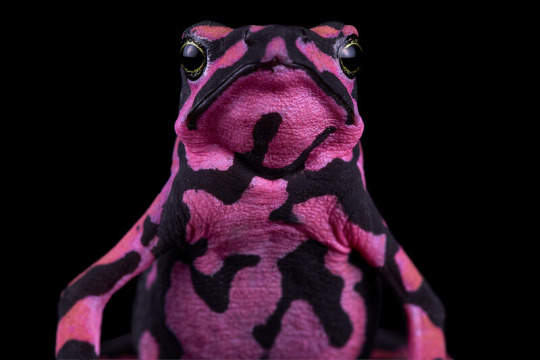
Bad Newts: Amphibians are in Serious Trouble
My colleagues and I have just had a paper published in Nature, based on our efforts to assess almost all amphibian species for the IUCN Red Lists. The major takeaway messages:
It is a bad time to be an amphibian
Two fifths of all amphibians are threatened with extinction.
Salamanders are the most threatened group; three fifths of all salamanders are threatened with extinction!
Climate change is a major driver of amphibian declines globally
Habitat loss, especially due to agriculture, is a problem for the vast majority of amphibians
Chytrid pandemics have caused and continue to cause catastrophic declines of both salamanders and frogs
Protected areas and careful management are working as strategies! They are actively improving the outlook of some species
As many as 222 amphibian species may have gone extinct in recent times; of those, 185 are suspected extinct but not yet confirmed.
Our paper is Open Access, you can read it here!
Photo of Atelopus hoogmoedi by Jaime Culebras, used with permission
#frogs#science#news#biology#zoology#newts#salamanders#amphibians#Nature#it's all over me#conservation#bad news bears#animals#this is my first Nature paper#sure I am just one of >100 authors#but I am still very excited#can you tell?#I wish I could write more about this#but I am in a grant crunch so no time#and also I have to run off to play d&d in like ten minutes#so here we are
3K notes
·
View notes
Text
Oh speaking of the Red List: saiga and scimitar-horned oryxes are no longer critically endangered! The IUCN recently updated its Red List of Threatened Species; they're now listed as Near Threatened and Endangered respectively.
1K notes
·
View notes
Text
So, I saw a post circulating here about the “extinction of birds in 2023“, with this picture attached
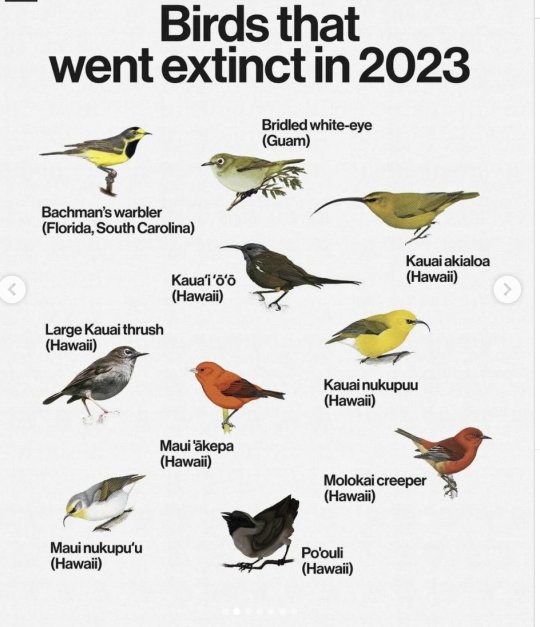
My, what a bold claim! All these poor birdies, “went extinct” in just one year alone? Why would such an outrageous, depressing and catchy claim be spread around?
Let’s fact check it.
All the species listed, Bachman’s wabler (Vermivora bachmanii, 1988 or 1980s), Kāmaʻo or large Kauaʻi thrush (Myadestes myadestinus, 1989 or 1987), Bridled white-eye (Zosterops conspicillatus, 1983 and 1983), Kauai ʻakialoa (Akialoa stejnegeri, 1969 or 1960s), Kauaʻi ʻōʻō (Moho braccatus, 1987 and 1987), Kauaʻi nukupuʻu (Hemignathus hanapepe, 1899 and 1899), Maui ʻakepa (Loxops ochraceus, 1988 and 1988), Kākāwahie or Molokaʻi creeper (Paroreomyza flammea, 1963 and 1963), Maui nukupuʻu (Hemignathus affinis, 1896* and 1996 ) and Poʻouli (Melamprosops phaeosoma, 2004 and 2004) are all, indeed, either extinct or possibly extinct, according to IUCN Red List of Threatened Species and U.S. Fish and Wildlife Service.
What are the dates after the scientific names? Well, those all are *last sightings* per IUCN Red List and USFWS accordingly. So, these birds were not seen for DECADES and in one case FOR MORE THAN A GODDAMN CENTURY. And sure as hell there is NO information about them very suddenly being gone all last year.
What’s the deal then? Where did this claim even come from? Well, likely from this article "21 Species Delisted from the Endangered Species Act due to Extinction" from U.S. Fish & Wildlife Service. It includes all the birds in the picture (with the last date of sight, listed above).
From the article: “The U.S. Fish and Wildlife Service is delisting 21 species from the Endangered Species Act due to extinction. Based on rigorous reviews of the best available science for each of these species, the Service determined these species are extinct and should be removed from the list of species protected under the ESA. Most of these species were listed under the ESA in the 1970s and 80s and were in very low numbers or likely already extinct at the time of listing.”
They didn’t ALL fucking suddenly drop dead all in the same year – if they did, as some other people have already pointed out, there would be an uproar EVERYWHERE. Ornithologists alone would not let it live down. They were officially delisted from endangered status by U.S. Fish & Wildlife Service that year, there was a proposition to do so back in 2021, too. Some were already declared extinct before by IUCN.
Despite not being seen for so long, they remained on the list of critically endangered for a long while, cause you cannot just immediately declare a species extinct. There’s no RTS unit amount number that goes to 0 once there’s nothing left; people keep checking for them over and over and over again. Sometimes it turns out that a species previously thought to be extinct is actually still out there. Attenborough's long-beaked echidna for example was last sighted SIXTY YEARS ago before being sighted again in 2023. It was thought to be extinct for a while, before 2007, when signs of its activity was spotted again. More often than not though, a species turns out to be actually very extinct, unfortunately – like in this case.
I cannot possibly know if the creators of this picture, or people that spread it on social media ever had good intentions behind it for awareness, however even if they did, it turned out to be nothing but very blatant misinformation, with a fearmongering effect. The only thing this achieves is not awareness of habitat destruction or pernicious tourist influence or climate change or what have you – the only thing this achieves is despair and panic. People already so casually fall into complete doomerism, they’re very used to hear bad news. And guess what doomerists do? Typically nothing. It renders people helpless. It’s not gonna make people get up and be ready for action, it, at best, would just make people feel sad and/or angry, or at worst, feed into the current alarming rise of ecofascism. NOTHING good comes out of this. At the very goddamn least, no one needs to lie to promote a goal.
The aim of the USFWS article, on the other hand, IS to make people aware about those animals that are already gone from the face of the planet, no matter how long ago, and that now we have to protect those animals that are critically endangered and still out there – to not have to repeat those tragedies.
Be very critical of what you see on the internet, especially if it’s sited with no sources. Especially-especially if it causes a strong emotional reaction. Lies and misinfo could only hurt the cause, no matter how noble. And please, be aware of your local wildlife status. Check in with it accoding to trusted sources.
[*sic, possibly a typo and it was meant to be 1996, other confirmed date listed there is 1989]
Addendum: I could not for sure find the uncredided (who woulda thunken that ppl that don't cite their sources would also not credit the artists) author(s) of the bird illustrations. If someone finds them, please, let me know!
Edit: Huge thanks to moosefinch for finding the sources for the artwork! I'll add their contribution below:
"Image sources!
The Kauai ʻakialoa, Kauaʻi ʻōʻō, Maui ʻakepa and Kauaʻi nukupuʻu are from Birds of the World.
The "Maui nukupuʻu" and "Molokaʻi creeper" illustrations are also Birds of the World, but are actually a female Kauaʻi nukupuʻu (the other being the male) and Laysan honeycreeper/Laysan ʻapapane respectively.
The bridled white-eye is by Lauren Helton according to this source.
Bachman's warbler is by Lynn Hawkinson Smith/smithhouse2 according to this Etsy listing.
The Poʻouli is by Christina Czajkowski."
#ah I just now see that the tumblr reblog of the pic and the twitter thread attached was deleted#yet the post is still in circulation. The damage lingers#so fucking irresponsible#fact check#misinformation#birds#bird#ecology#environmentalism#extinction#conservation#species conservation#animals#hawaiʻi#important
809 notes
·
View notes
Text
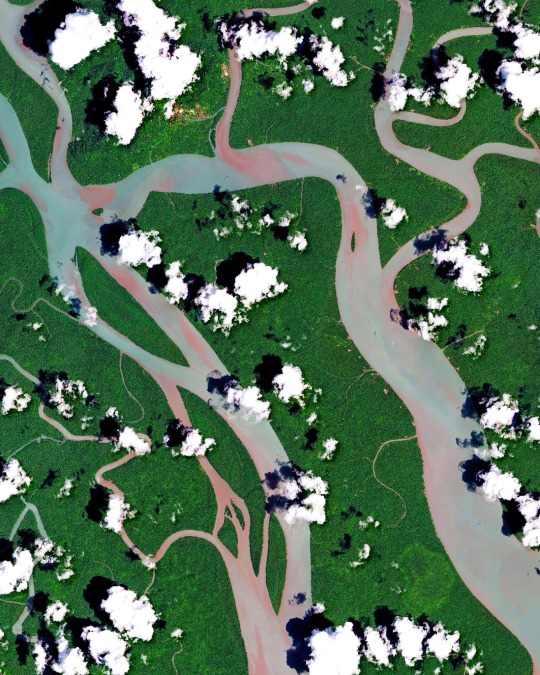
Clouds float over the Kikori River Delta in southern Papua New Guinea. Part of the Gulf of Papua, this coastal mangrove forest is considered one of the most important wetland regions in the Asia-Pacific due to its cultural and biodiversity value. It is a habitat for Indo-Pacific humpback and Australian snubfin dolphins, both listed as “vulnerable” on the IUCN Red List of Threatened Species.
-7.428366°, 144.428927°
Source imagery: Airbus Space
497 notes
·
View notes
Text
The destruction of wetlands is driving the decline of dragonflies worldwide.
According to the first global assessment of these species in today’s update of the IUCN Red List of Threatened Species™. Their decline is symptomatic of the widespread loss of the marshes, swamps and free-flowing rivers they breed in, mostly driven by the expansion of unsustainable agriculture and urbanisation around the world.
#IUCN Red List of Threatened Species#Dragonflies#threatened species#Marches#swamps#free-flowing rivers#habitat loss
0 notes
Text
The IUCN Red List now includes 138,374 species of which 38,543 are threatened with extinction.
Four commercially-fished tuna species are on the path to recovery thanks to the enforcement of regional fishing quotas over the last decade, according to today’s update of the IUCN Red List of Threatened Species™ released at the IUCN World Conservation Congress in Marseille. However, the recovery comes in the midst of growing pressures on marine species, with 37% of the world’s sharks and rays now threatened with extinction primarily due to overfishing, compounded by loss and degradation of habitat and climate change.
0 notes
Text
all the terrible terrible things that happened in DP but got glossed over because it's a cartoon show (aka the source of all the phandom's horror inspirations)
Dissection (mentioned several times. attempted by Maddie Masters although it was more of a threaten for answers kind of thing. also attempted by Vlad to determine why Dani lasted longer than other clones)
Brainwash (Plantwash by Undergrowth via invasive plant tentacles, Musicwash by Ember's music)
Possession (out of context of cartoon shows, if someone loses autonomy to an unknown someone else controlling their body, this would be terrifying. this happened on massive scale in this cartoon show several times and more frequently on smaller scale) (Freakshow's red orb staff fits here more than in the Brainwash section)
Spectra's quest for immortal youth (because this is a kid's show, instead of bathing in virgin's blood for immortal youth like Bathory, Spectra made do with binging on teenagers' emotions. depression isn't a joke but Spectra hands it out like candy)
Can it be gore if there's no red? all the ghosts that were implied to have been caught by the Fentons, the GIW, and Vlad for the purpose of experimentation to develop their ectoequipments (bonus: the melted Danny clones that were implied sentient and aware)
Dehumanization (all the ghost hunters did this to validate their actions. Vlad where did you draw your mental line between the melted Danny clones and the prime clone?)
the Mutant Food (the Fentons are lucky that those things haven't gained enough intelligence to take over their weapon stash yet. re: crab with a knife)
Cannibalism?? (this one is debatable since all the materials in ghost zone are made out of ectoplasm, are all ghosts the same species? where's the line drawn at?)
OSHA violations (let's see.. resulted in the creation of Vlad Plasmius, Danny Phantom, mutant food. possibly an on-going process of creating a haunted FentonWorks except Danny is already haunting FW.) (also ectoplasm glows. is it radioactive? highly mutagenic- see: mutant food. the Fentons claims their ectoweapons are safe but they're wearing hazmats, the people they sometimes accidentally shoot ectoplasmic goo at don't have hazmat protective suits) (do they have proper disposal protocols? or are they polluting Amity Park with highly mutagenic and likely radioactive ectoplasm?)
Technus' world domination (why wait for AI domination like skynet and the matrix when we have Technus)- this one is underutilized plot but Technus can become a high level threat without proper counter (reminder: he had access to nuclear weapons for a hot minute)
the Plasmius-Phantom merge into Dan/Dark Danny/Dark Phantom (they just merged grieving kid's soul with the soul of an old man obsessed with the kid's mom, is it any wonder that they didn't come out sane?)
Danny's repeated deaths (death by portal zap count: 2)
the time GIW tried to nuke Ghost Zone (and consequently, the Reality out of sheer ignorance)
The reblog with Vlad's list of crimes here
682 notes
·
View notes
Text
In the absence of human influence wildlife is thriving in and around the Chornobyl Exclusion Zone

Przewalski's horse herd
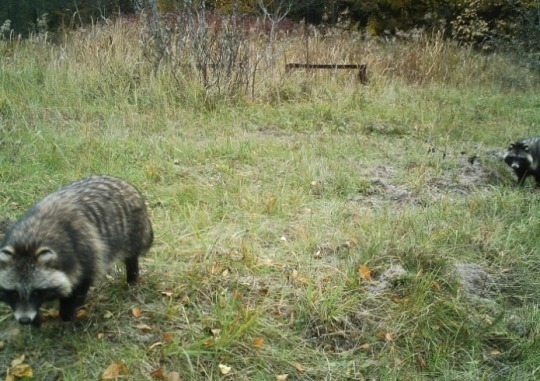
Common raccoon dogs, relatives of the tanuki

A black stork carrying materials for its nest. Black storks are included in Ukraine's national red list of threatened animal species
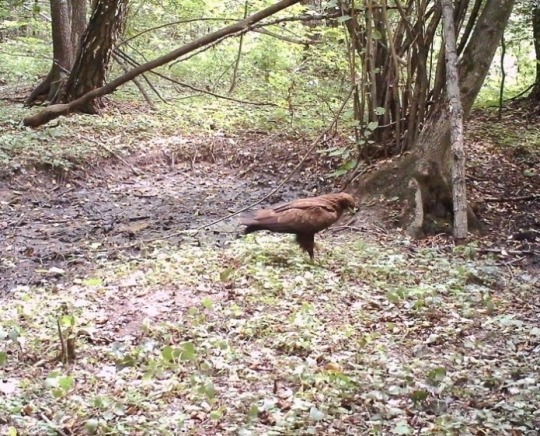
Another species on the red list: the lesser spotted eagle

The first record of wild European bison in Kyiv Polissya for over 300 years

Mother lynx with her cub
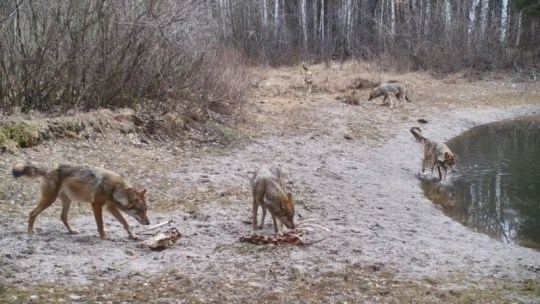

Several packs of wolves have established themselves in the area

Another family; this time wild moose

A couple of deer saying hello to the camera
These pictures were made using "camera traps" set up by Ukrainian zoologist Serhiy Hashchak who has been observing and monitoring wildlife in Chornobyl for years. Currently this was made impossible by the ongoing invasion and war threatening both human and animal life.
1K notes
·
View notes
Text
DYK…
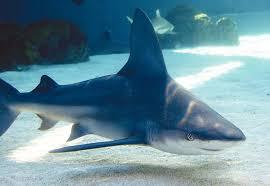
sandbar shark have a large first dorsal fin, large pectoral fins and a mid-dorsal ridge. like many other shark species, sandbar sharks give birth to live young.
sandbar shark are named for the sandy flats, bays and estuaries where it's found. In fact, it's the most common species of shark in the Chesapeake Bay!
sandbar sharks are believed to live more than 30 years. Although sandbar sharks are listed by the IUCN Red List as only Lower Risk/near threatened, they are severely overfished in the western North Atlantic.
#sea creatures#marine life#shark#marine biology#sea#sharks#water#sealife#ocean#aquatic#ocean life#marine animals#sea life#sandbar shark#aquarium#i like sharks (and getou’s balls)
104 notes
·
View notes
Text

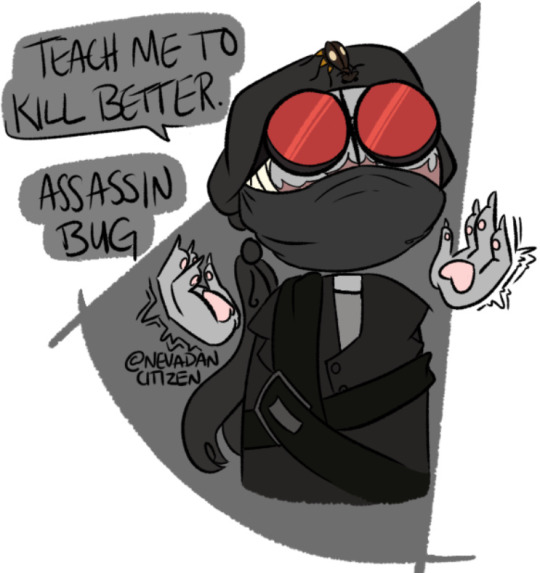
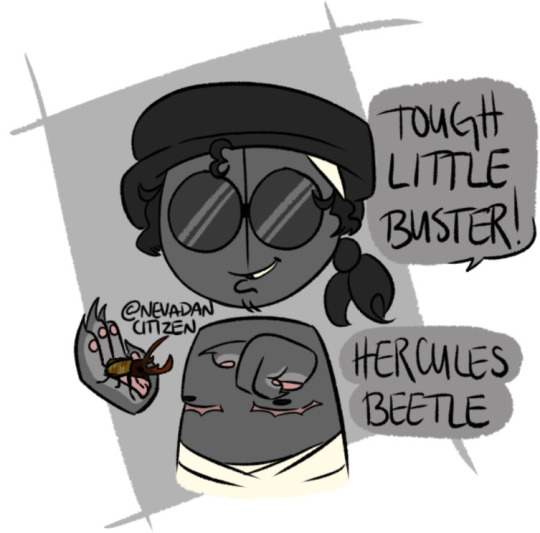

moved house recently and the movers literally destroyed my insect display case and the specimens inside so i drew the sillies with the insects i think would represent them best to soothe the pain. explanation below the cut (be warned, it’s long and so so fucking nerdy)
(+ sanford bombardier beetle follow-up)
okay so first is doc with a madagascar hissing cockroach. despite cultural connotations, cockroaches are some of the smartest insects (up there with bees, wasps, and termites (which they share an order with — blattodea)), and doc is nothing if not the brains of SQ. madagascar hissing cockroaches are some of the few insects that stay with their offspring for a long while, therefore protecting them. doc is also protective of his men in a somewhat similar fashion, albeit from a distance and behind a cold, stern demeanor. also these roaches can’t fly, and doc can’t drive. there’s a joke in there somewhere but i can’t find it.
then we’ve got hank with an assassin bug. there’s not really any notable species within the family, so it’s just supposed to be a general insect within reduviidae (but not an ectoparasite). some assassin bugs transmit chagas disease, which is mostly always unwanted and detrimental, much like hank’s presence to anyone outside of SQ (or within the SQ, because hank’s loyalty mostly just faults to his own bloodlust). assassin bugs also have one of the most painful insect bites but, unlike hank, they use chemicals (injected via proboscis) to induce pain rather than ripping and tearing. still, the end result is the same.
obviously, what else would sanford have other than a hercules beetle? they’re one of the strongest insects (as evidenced by the horns on their head and prothorax), and sanford is, unarguably, the strongest grunt of the SQ. male hercules beetles use their horns to grapple and fight (both for territory and mates), and sanford also uses very melee-heavy tactics while fighting. they also use their horns to leverage and throw their opponents, and sanford uses his hook with similar tactics. these beetles are very hardy (due to their exoskeleton and hardened elytra) just like sanford, despite his usual lack of clothing and armor.
lastly, there’s deimos and the australian tiger beetle. they’re known as the fastest species of tiger beetle (up to 9 km/h or 5.6 mph) and — not sure if this is canon or a universally accepted headcanon — deimos is the fastest grunt of the SQ. these beetles run so fast and hunt so aggressively that their sensory system literally can’t keep up and their eyes shut off, so they have to stop often (for just a fraction of a second) to regain their faculties, which gives their prey several chances to escape. this reflects in deimos through his jokey demeanor and tendency to not take things seriously until it’s too late. thankfully, the australian tiger beetle is only listed as “near threatened” on the red list, unlike deimos, who is totally fucking dead.
thank you for coming to my ted talk which is just me smushing my two special interests together like a child mixing play-doh
#riptide’s drawings ✏️#madness combat 🆘#also peek at doc’s filed-down claws i really like that little detail#madcom#madness combat#madness combat deimos#madness combat sanford#madness combat hank#madness combat 2bdamned#madness combat doc#deimos#sanford#hank j wimbleton#2bdamned#madcom deimos#madcom sanford#madcom hank#madcom 2bdamned#madcom doc#madness: project nexus#project nexus
111 notes
·
View notes
Text
Located 62km north-east of the capital Manila, Daraitan village in Rizal province is home to about 5,700 residents, a majority of whom are members of the Dumagat-Remontado indigenous people who consider vast hectares of the mountain range as part of their ancestral domain.
But the village may soon disappear under the same waters that give it life, once the Philippine government finishes building the Kaliwa Dam – one of 16 flagship infrastructure projects of former president Rodrigo Duterte that is being funded by China.
The new dam is expected to provide Metro Manila with an additional 600 million litres of water daily once it is finished by end-2026. Officials said building the 60m-high reservoir is even more necessary now that the country is starting to feel the impact of the El Nino weather phenomenon.
But it was only in 2021 under Mr Duterte that construction finally broke ground, three years after Manila and Beijing signed the 12 billion peso (S$288 million) loan agreement.
Of the 119 on the list [of flagship projects of the "Build, Build, Build” infrastructure programme], Mr Duterte turned to China to finance 16 big-ticket projects in a bid to cement his legacy by the time his presidency ended in 2022. He embraced Beijing during his term and even downplayed Manila’s claims in the disputed South China Sea in favour of securing loans and grants from China.
Analysts have criticised Mr Duterte’s infrastructure programme as ambitious. Perennial domestic issues like local politics, right-of-way acquisition problems, lack of technology and red tape in bureaucracy led to severe delays in the projects.
The same issues hound the China-funded projects – which come under Beijing’s Belt and Road Initiative (BRI) to build infrastructure in developing nations – with the problems made more severe by Beijing’s high interest rates in its loan agreements and local backlash due to displacement of residents or potential environmental damage.
Critics say the BRI has been detrimental in the long run to some recipient countries, especially those that have been unable to repay their loans, like Sri Lanka and Zambia.
The Duterte government’s failure to take advantage of its BRI loans was a “missed opportunity” for the Philippines, said infrastructure governance specialist Jerik Cruz, a graduate research fellow at the Massachusetts Institute of Technology.
The four completed China-funded projects under Mr Duterte were controversial too. But they came to fruition because they had the support of local politicians allied with Mr Duterte and therefore increased his political capital, said Dr Camba.
Tribal leaders said they were not properly consulted regarding the project that threatens their traditional way of life. Environmentalists from the Stop Kaliwa Dam Network also say the project would destroy 126 species of flora and fauna in the Sierra Madre.
The Philippines’ Indigenous Peoples’ Rights Act states that the government must first secure a tribe’s free, prior and informed consent before building on its ancestral lands.
But Ms Clara Dullas, one of the leaders of the Dumagat-Remontado in Rizal, alleged that the Duterte government had either misinformed or pressured other tribe members into giving their consent.
She could not bear to hold grudges, though, noting that the Dumagat-Remontado organisations that eventually agreed to the Kaliwa Dam were each given 80 million pesos, or $1.9 million, in “disturbance” fees.
“The Kaliwa Dam is the reason why our tribe is divided now. There is a crack in our relationships even if we all come from the same family,” said Ms Dullas. “I can’t blame the others because we lack money. I believe there was bribery involved.”
The government requires them to present identification documents, and only those given passes may enter. Mr Dizon said this is to ensure that no unidentified personnel enter the area [close to the construction zone].
“We feel like we are foreigners in our own home because the Chinese and the people in our own government are now preventing us from entering the lands where we grew up,” said tribe leader Renato Ibanez, 48.
Mr Ibanez also accuses the Philippine authorities of harassing tribe members who are vocal against Kaliwa Dam. Some of them have been accused of working with communist rebels, a charge the tribe vehemently denies.
Unlike his predecessor, Mr Marcos is more aggressive in defending Manila’s overlapping claims with Beijing in the South China Sea, but still fosters economic ties with it.
Geopolitical tensions between the two nations and Mr Marcos’ stance towards Beijing are going to dictate the fate of the pending China-funded projects the President inherited from Mr Duterte, said Mr Cruz.
Tribe members said they would be more amenable if Mr Marcos would revisit Japan’s proposed Kaliwa Intake Weir project that Mr Duterte had set aside.
“We like Japan’s proposal. It would not destroy our forests. It would not affect residents here. The Philippines would not be buried in debt,” said Ms Dullas.
This was among the alternatives the Dumagat-Remontados offered during their nine-day march in February 2023, when some 300 members walked 150km from Quezon and Rizal all the way to Manila to protest against the Kaliwa Dam.
But they failed to secure an audience with Mr Marcos. They remain wary of the President’s position on the Kaliwa Dam and other controversial China-funded deals.
“As much as we want to fully pin our hopes on him, we don’t. We’ve learnt from past efforts to trick us, make us believe a project is about to end, only for it to be resurrected again years later,” said Ms Dullas.
2024 Mar. 3
#philippines#indigenous rights#dumagat-remontado#state violence#red tagging#infrastructure#environmental issues#afp-pnp
54 notes
·
View notes
Text
White Sturgeon
Acipenser transmontanus is a North American Species of sturgeon commonly known as white sturgeon. White sturgeon grow around 6 feet long on average. They can be found along the western coasts, estuaries, and river systems of North America, ranging as far south as Baja California and as far north as the Aleutian Islands. Groups of white sturgeon from different river systems exist in pockets of relatively steadfast isolation from each other. They are so isolated, in fact, that white sturgeon in different river systems and estuaries have evolved different numbers of chromosomes. Small white sturgeon mostly eat invertebrates, but larger adults consume fish as well. These fish used to be one of the staple food sources of the local indigenous populations, but their populations were greatly threatened by commercial fishing for meat and caviar in the early 1900s. Today, the white sturgeon is listed on the IUCN Red List as vulnerable.

[on a personal note: sorry for the lack of sturgeon facts lately, I have been very very depressed. I am going to be partially hospitalized for two weeks starting tomorrow, so hopefully that will get me back on track and I’ll have the energy to write about my favorite creatures again]
#sturgeon fish#sturgeon#fish#ichthyology#marine biology#acipenseridae#fish facts#sturgeon facts#white sturgeon#acipenser transmontanus
213 notes
·
View notes